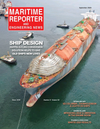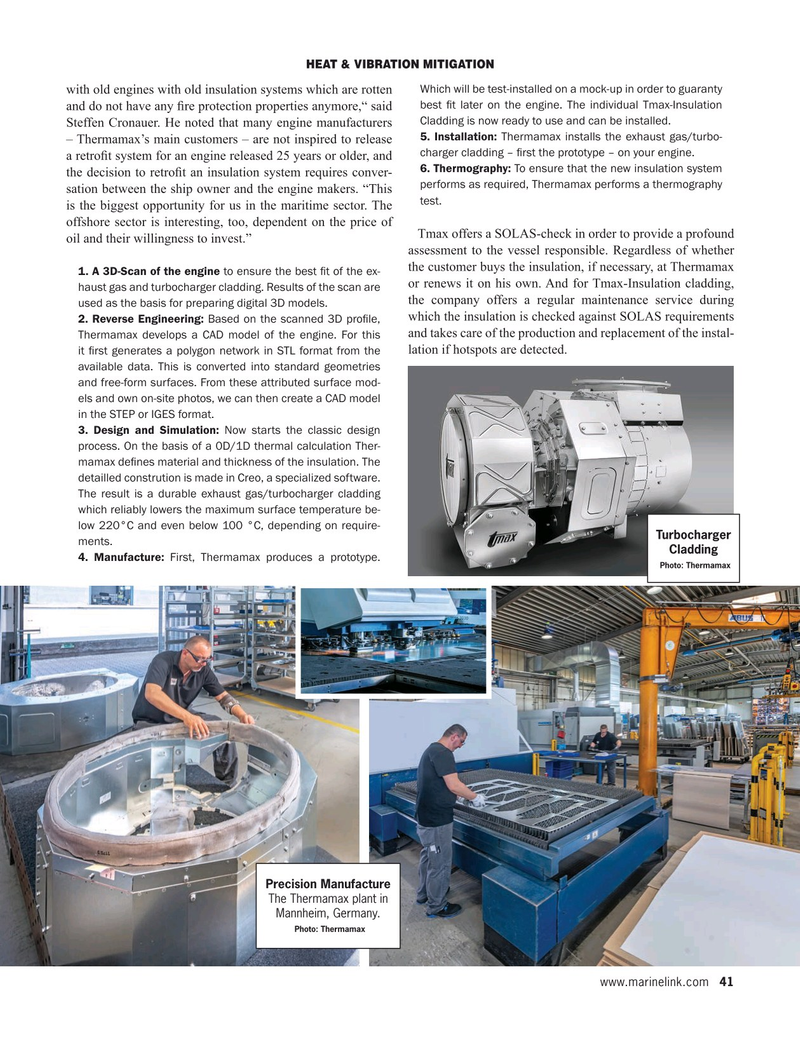
Page 41: of Maritime Reporter Magazine (September 2020)
Marine Design Annual
Read this page in Pdf, Flash or Html5 edition of September 2020 Maritime Reporter Magazine
HEAT & VIBRATION MITIGATION
Which will be test-installed on a mock-up in order to guaranty with old engines with old insulation systems which are rotten best ? t later on the engine. The individual Tmax-Insulation and do not have any ? re protection properties anymore,“ said
Cladding is now ready to use and can be installed.
Steffen Cronauer. He noted that many engine manufacturers 5. Installation: Thermamax installs the exhaust gas/turbo- – Thermamax’s main customers – are not inspired to release charger cladding – ? rst the prototype – on your engine.
a retro? t system for an engine released 25 years or older, and 6. Thermography: To ensure that the new insulation system the decision to retro? t an insulation system requires conver- performs as required, Thermamax performs a thermography sation between the ship owner and the engine makers. “This test.
is the biggest opportunity for us in the maritime sector. The offshore sector is interesting, too, dependent on the price of
Tmax offers a SOLAS-check in order to provide a profound oil and their willingness to invest.” assessment to the vessel responsible. Regardless of whether the customer buys the insulation, if necessary, at Thermamax 1. A 3D-Scan of the engine to ensure the best ? t of the ex- or renews it on his own. And for Tmax-Insulation cladding, haust gas and turbocharger cladding. Results of the scan are the company offers a regular maintenance service during used as the basis for preparing digital 3D models.
which the insulation is checked against SOLAS requirements 2. Reverse Engineering: Based on the scanned 3D pro? le, and takes care of the production and replacement of the instal-
Thermamax develops a CAD model of the engine. For this lation if hotspots are detected. it ? rst generates a polygon network in STL format from the available data. This is converted into standard geometries and free-form surfaces. From these attributed surface mod- els and own on-site photos, we can then create a CAD model in the STEP or IGES format. 3. Design and Simulation: Now starts the classic design process. On the basis of a 0D/1D thermal calculation Ther- mamax de? nes material and thickness of the insulation. The detailled constrution is made in Creo, a specialized software.
The result is a durable exhaust gas/turbocharger cladding which reliably lowers the maximum surface temperature be- low 220°C and even below 100 °C, depending on require-
Turbocharger ments.
Cladding 4. Manufacture: First, Thermamax produces a prototype.
Photo: Thermamax
Precision Manufacture
The Thermamax plant in
Mannheim, Germany.
Photo: Thermamax www.marinelink.com 41
MR #9 (34-49).indd 41 9/9/2020 8:57:42 AM

 40
40

 42
42
